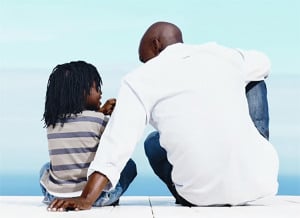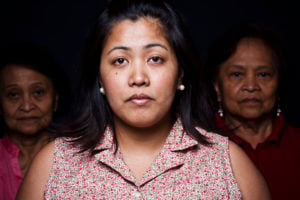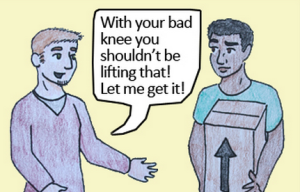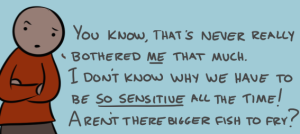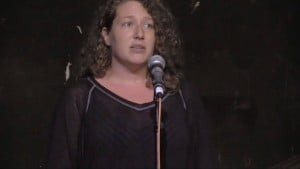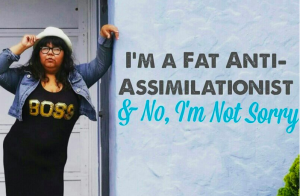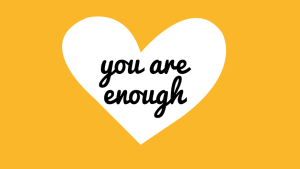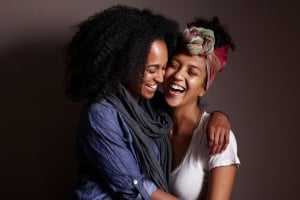
Young adult extends their hand to comfort a friend. They are standing in an urban setting.
I’ve been studying White allies to Black people recently. The upswing in publicized violence against unarmed people of color and the normalization of race hatred marking the Trump campaign has brought White allies more demonstrably into my corner.
Even people who prefer neutrality, and have long had the advantage and comfort of having no position, will become allies when beautiful Black boys are filmed being mowed down in broad daylight and their killers walk away with impunity.
The violence against people of color is so systemic, so deeply rooted, so widespread, and so frequent that I welcome allies from all walks of life and at any stage of their ethical evolution into the movement against race-based hatred and violence.
Although some race-privileged people are coming late to ethical awareness of anti-Black violence (for Black folks have been saying the same thing forever about police violence, vigilantism, and plain-old, everyday racism), we need all the allies we can get.
While I’m grateful for the way that White allies express solidarity with Black life these days, I wonder if they could consider a subtler dynamic that is often in play: that how we stand in solidarity – especially, I think, how people in the skin and tradition of the White oppressor do so – can make the difference between opening channels and slamming them shut.
How White allies regard Black acquaintances in the aftermath of White supremacist violence can make the difference between a new, nuanced, mutual respect and the unconscious repetition of age-old, ugly dynamics.
Both seasoned and new White allies to the cause of Black justice, for example, could pay better attention to their presumptions about people of color’s need for their emotional support during highly publicized incidents of racism. They could be less invasive than reaching out to console us during a time of anti-Black tragedy without knowing how one of us is feeling or whether one of us appreciates connecting gestures like hugs and tears and words of consolation.
I frequently sense superficiality and even condescension behind what are supposed to be affirming gestures.
This difference between the likely intent of such gestures and the manner in which they may be received is a complex dynamic. But it strikes me as one that has to do with privilege, that race-class advantage that sociologist and White ally Allan G. Johnson characterized as a paradox: a thing that contains two opposite elements that contradict one another (in the way that solidarity and condescending insult do).
Privilege, according to Johnson, operates within a “relatively wide [emotional] comfort zone” that marginalized people in predominantly White spaces may not experience. Thus, expressing true solidarity with Black folks in times of highly publicized White supremacist violence can be tricky business for White allies.
They must be willing to be uncomfortable in order to self-assess their motivations and to fully self-screen for pity, fragility, or unproductive guilt when anti-Black tragedy strikes.
White allies would also do well to notice the broad range of our responses to anti-Black violence, especially in times of tragedy. They would do well to question their assumptions about our neediness and consider checking their impulse to console us. Especially in public spaces and especially at moments in which anti-Black violence has made the news, allies could connect in ways that are more empathetic and supportive and that feel less pitying to us.
Here are a few:
1. Ask Questions and Make ‘I’ Statements
Consider your own emotional boundaries.
When something awful happens, you likely have an invisible line around you that separates what feelings you want to keep to yourself and what you want to share with the world. You likely have certain people you want to talk to and others who fall outside of the line that divides confidante from acquaintance. You likely have times and intimate spaces away from professional, formal, or public places where you prefer to talk about disturbing things.
So, of course, do we.
Instead of assuming where we’re at and what we need, you can take an additional step that amounts to determining our emotional boundaries around cross-racial communication about race-hatred and race-based violence.
“I feel awful about today’s news. I feel like talking. Do you?” sounds a little corny, but otherwise seems like a reasonable thing to say between friends. It doesn’t burden me by unburdening you, it doesn’t come from the top down, it doesn’t lead with presumptions, and it does clarify boundaries.
It gives me opportunity to say “no, not really” and go on with my day.
It gives me the opportunity to say, “Thank you. Yes, let’s sit down.”
2. Learn the Range of Our Strengths
My own awareness of race-based hatred is almost as old as I am. My introduction to race was racism itself; it was the daily experience of living in a world in which people communicated that I was somehow different from them in a way that signified less than.
Sometimes these demonstrations and articulations were life- or safety-threatening. Sometimes they were obstructive to my freedom or my success, and sometimes they were merely annoying or hurtful.
But regardless, I’ve had several decades of getting used to what saddens me about this deeply prejudiced world and feel how I feel about it. I’ve learned to proceed through life as if there’s no ceiling over my head, mined my community for strategy and/or comfort when that ceiling arises, and offered my support when America’s racial pathology becomes personal for someone I love.
I like to think that in that time, I’ve gained a good skill set for coping and even gleaned some resilience.
Yet allies in pity mode are not considering the strength or resilience of the objects of their pity. When they reach out, they are assuming a wound that they can nurse.
Put differently, they are setting the rules of the interaction to their own standard and judging what they think should be my feelings according to theirs.
It’s a function of their privilege. Privilege that, according to Allen G. Johnson in Privilege as Paradox:
“increases the odds of …being able to set the agenda in a social situation and determine the rules and standards and how they’re applied. It allows people to define reality and to have prevailing definitions of reality fit their experience… It grants a presumption of superiority and permission to act on that assumption without having to worry about being challenged.”
White allies who cross my emotional boundaries after vigilante violence (especially in public spaces at impromptu moments) are putting me in a position to consider whether I want to confront them to challenge unwanted consolation.
White allies define reality when they indulge curiosity without regard to Black people’s feelings.
I will never undervalue the importance of White allies, and I deeply believe that the commitment of people standing in solidarity with one another during moments of shock and despair is the most crucial stuff of life.
But when White allies seek to connect out of pity, they aren’t considering either the range of my options for holding my head up through tough times or my preference for crying in private or talking things out with like-minded, intimate friends.
3. Respect Our Distance – With or Without Explanation
It’s rare that any person wants to be singled out by their skin color for random, brief connection over a tragedy.
I certainly avoid it.
But when I back off from a person trying to make me rehash the events of a terrible anti-Black crime, express an outrage, talk my feelings out, or something, I’m accustomed to being regarded as if I’m cold or unfeeling!
If I don’t want to watch a Facebook video of a person being brutally shot to death and then discuss my feelings about it, it’s like I’m wrongly wired.
I was asked once during the Ferguson protests, “How do you take it, sending your husband and son out the door each day. Aren’t you scared that something will happen to them?”
As if the impromptu tapping into my worst fears could ever be anything short of wildly insensitive, inappropriate, voyeuristic, and self-motivated in the extreme, I was met with hurt feelings when I shut the questioning down. That was a rare degree of intrusion, thank goodness. But allies often seem similarly offended when I change the subject for less dramatic reasons.
Without me having to explain my reluctance, true allies would consider what they’re trying to flip open in me to satisfy their own curiosity or need to connect.
They might discover some things. Perhaps I’m not cold or unfeeling. Perhaps I’m simply aware of how flipping open Pandora’s box of American racism will make me feel at any given moment: furious in a way that makes it difficult for me to go about the mundane things that I need to do each day.
And so staying closed is a way for me to simply maintain. An ally who’s really an ally should respect the distance and respect emotional boundaries.
4. Turn the Gaze Inward Sometimes
Being a person of color in as conflicted and volatile a society as this one frequently feels to me like being under a microscope or in front of a floodlight.
Majoritarian press, social science, public dialogue, and intrusive individuals seem to deflect attention from themselves and always focus on us: what we’re doing to get shot at, why we riot, why we protest, whether we commit more crime or not, where our youth are wearing their pants, how we’re living, what we’re doing, in short, what’s wrong with us.
It’s like being in front of a searchlight in the dark. I can’t see the person holding the searchlight; it’s far too bright, and they’re obscured. But they can see any and everything about me.
How many times in life have I felt that way – scrutinized, overexposed, over-looked at, too questioned under what Toni Morrison calls the White gaze – when I’m simply going about existing in my own skin?
If I could get White allies to do any one thing it would be this: turn the scrutiny in toward to themselves instead of having one-sided focus on the Other. Especially in social science and public political debate, almost all dialogues on race relations are, first of all, binary: reduced to Black-White only. Second of all, when they are appropriately about White-Black dynamics, race discussions are almost always focused on Blacks.
When a White supremacist shoots an unarmed Black person and claims they are “scared,” the dialogue turns to the scariness of Black folk and people wearing hoodies.
When White supremacy as a system is oppressing a segment of society, the floodlight is cast onto the survivors of the system:
- our unwed mothers
- our incarcerated fathers
- our drug use
- our failure in education
- our rates of violence
Native, Latinx, and Black achievers become a non-thing, and White unwed mothers, White incarcerated fathers, Write drug users, White school drop outs, and especially White killers, stay behind the floodlight.
The White supremacist capitalist system that stacks the cards against minorities stays far behind the floodlight. And important discoveries like the hate group infiltration of police departments, remain undiscussed.
The best, most effective White allies, however, turn the gaze to their own citizens and leaders and, in an effort to best aid minority communities, hold their own people to a higher standard.
There are hundreds and hundreds of examples in White history that could serve as inspiration, some of which might surprise you:
- Orson Welles’ scathing criticism of vigilante anti-Black violence
- The White women of Homerville Alabama who petitioned a White Southern judge and saved a Black man from being lynched (see: 100 Years of Lynching by Ralph Ginzburg)
- White people, like Joan Trumpauer, critical of Jim Crow segregation, willfully jailed alongside Blacks during Civil Rights
- Albert Einstein’s compelling challenge to White complacency regarding the so-called “Negro problem”
- Studs Sterkel’s interviews with and exposure of former Klan leader C.P. Ellis
White allies may not always be in position to make epic gestures like these. But wherever White allies are, there is opportunity to turn the gaze inward – around to themselves and their community.
At the very least, smaller, more individual turns inward seem important during times of public, anti-black crises.
An ally might pause to ask: How am I feeling today at this most recent shooting? What should I do with this feeling that I have? What’s my role in bringing about change? Who is it appropriate for me to talk to about my feelings and my roles?
In ways such as this could White allies take a small burden – defending our emotional boundaries from outsider curiosity – off our plates.
[do_widget id=’text-101′]
Sarah T. is a native of suburban Philadelphia, a writer, editor, writing instructor, wife, mother, and critical race theorist living in Anacostia, SE, Washington, DC. Her creative work has appeared in Azure literary magazine and the Sally Hemings Dreams ‘zine, and she expects her book-length collection of poetry and prose to be out in spring. Her reflection on the sankofa ethic in education will appear this October in the Black Lives Matter special issue of Radical Teacher, and her online teacher re-education resource and blog – the Sankofa Love Project – is expected to go live this coming summer.
Search our 3000+ articles!
Read our articles about:
Our online racial justice training
Used by hundreds of universities, non-profits, and businesses.
Click to learn more







